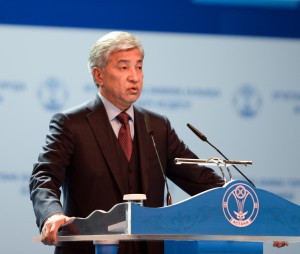 ASTANA – Akim (Mayor) of Astana Imangali Tasmagambetov reviewed the city’s progress and discussed economic goals at a public meeting in Astana on Feb. 19. Major achievements include growth in industrial production and support for small and medium-sized businesses; goals include diversifying the service sector.
ASTANA – Akim (Mayor) of Astana Imangali Tasmagambetov reviewed the city’s progress and discussed economic goals at a public meeting in Astana on Feb. 19. Major achievements include growth in industrial production and support for small and medium-sized businesses; goals include diversifying the service sector.
As one of the seven values of the Mangilik Yel (Eternal Nation) national idea expressed by the President in his recent state-of-the-nation address, the capital is taking a growing role in the development of the country, Tasmagambetov said, and last year laid a solid foundation for growth. Gross regional product (GRP) amounted to 2.7 trillion tenge (US$14.6 billion) and industrial enterprises produced goods and rendered services worth more than 263 billion tenge (US$1.4 billion). By 2020, municipal authorities want services to be 80 percent of GRP.
“The capital is growing rapidly, but the service sphere isn’t always keeping up. Small and medium-sized businesses should be diversified to meet the modern principle of step-by-step availability and expand the net of their branch activities. That’s why the state fully supports business initiatives [and] lending to entrepreneurs,” said Tasmagambetov. In 2013 alone, more than 6,000 businesses received real assistance under the Business Road Map 2020 state programme, he said. Tasmagambetov also noted that today, small and medium businesses are helping develop the middle class, which the President says is of major importance.
“Already today, small and medium-sized business accounts for 67 percent of tax revenues to the city budget. The volume of their products over the past year made up 1.2 trillion tenge (US$6.5 billion),” Tasmagambetov said. “By 2017, we have every possibility of increasing the number of small and medium-sized businesses to 60,000.”
A significant proportion of the 1 trillion tenge (US$5.4 billion) allocated on the President’s instruction from the National Fund in 2014 and 2015 to provide the real economic sector with credit resources will be also available to small and medium-sized enterprise in the capital, he said.
An industrial park created to implement investment projects in the capital has produced goods and services worth more than 120 billion tenge (US$649 million) over the past three years, 45 percent of the city’s industrial production volume. Industrial production in the capital has doubled since 2010, from 111 billion tenge (US$600 million) to 263 billion tenge (US$1.42 billion) in 2013, Tasmagambetov reported.
By 2017, the mayor said, the industrial park’s output will be about 250 billion tenge (US$1.39 billion) annually and over 8,000 new jobs are expected to be opened. Tax revenues will quadruple and reach 70 billion tenge (US$378 million); the share of local content in goods and services will approach 70 percent.
Much work is to be done in the sphere of urban infrastructure, the mayor said. The ambitious BRT project – high-speed buses, running in specially allocated lanes, – is intended to relieve the public transport system and prepare the capital for hosting EXPO 2017. In June this year, construction of the first BRT line will be launched. Its completion is scheduled for 2016.
Regarding social issues, Tasmagambetov said that the amount of children’s and social benefits and targeted social assistance will be increased from April 1, 2014 not by 12 percent, but by 16 percent, according to the President’s orders on social support after the devaluation of the tenge. Today in the capital there are 3,999 recipients of social assistance.
The mayor spoke positively about the recent correction in the tenge exchange rate, saying it would help curb the growth of import volumes, revive the internal market, support domestic producers and save Kazakhstan’s gold reserves. In addition, he said, the measure will increase the incomes of exporters and the state budget, attract additional financial resources to the Kazakh economy and allow the state to reinvest money from exports into the domestic economy.


